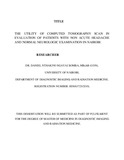| dc.description.abstract | Objectives
To assess the utility of computed tomogram scan (CT scan) in neuroimaging of patients
presenting with non acute headache and normal neurologic examination, and to determine the
pathological yield in terms of qualifications of referring doctor, age, sex, duration of headache
and type of clinically diagnosed headache syndromes.
BACKGROUND:
Headache is one of the most common reasons why patients go to see a doctor. Majority may not
have a serious cause for the headache but a minority will. Headache is majorly classified into
primary and secondary headache. Primary headache is a type of headache which is not associated
with any demonstrable organic disease or structural neurologic abnormality, on the other hand,
secondary headaches include those headaches caused by underlying medical condition. Primary
headache is the commonest type of headache. Neuroimaging for primary headaches yields very
low intracranial positive results for pathology. Despite this being the fact, patients with primary
headache are referred in-discriminatively for head CT scan. There is no local study done on use
of CT scan as part of investing patients with non acute headache and normal neurological
examination.
It is important to study the pattern of patient referrals in Nairobi for Head CT scan in patients
with primary headache and find out whether the primary clinicians do make a specific clinical
diagnosis before referring. The level of positive pathological yields will be a good indicator on
whether this examination is necessary, hence provide basis for the development of a guideline to
be followed before doing neuroimaging on these patients in Nairobi.
METHOD:
One hundred cases that were referred to Kenyatta national hospital and Plaza imaging solutions
for head CT scans with complaints of non acute headaches without focal neurological deficit,
were recruited into the study after signing an informed consent. The patients were recruited
through convenient sampling. The researcher went through the request forms and administered
the questionnaire to the patients before including them into the study. This was done prior to
doing the CT scan examination. The patients were recruited randomly from all the patients send
for imaging in these facilities during the period of study. The researcher reviewed the images
with a qualified specialist Radiologist. All these variables were analyzed to find out the proportion and characteristics of study cases that had identifiable abnormalities. Age, sex,
duration of headache, type of headache, qualification of referring doctors and the distribution of
CT findings were described from a frequency table.
RESULTS
Mean age of the cases was 36.7 (SD16.6) years. Majority were female making 65%. 78% were
referrals from medical officers and Only two patients ( 2%) had findings of solid intracranial
and base of skull pathological lesions. The two were referrals from consultant neurologists. 44%
had normal head CT scan findings, 43% rhino sinusitis, 8% had brain atrophy and 3% had
mastoiditis.
CONCLUSION:
In patients with non acute headache and normal neurological examination, intra cranial
pathological yield was too low. Therefore, there is need to establish a guideline to be followed
before referring these patients for head CT scan.
Significant extra cranial pathologies were detected. Most of the patients did not have definite
clinical diagnosis. If clinicians did adequate clinical examination and took thorough clinical
history, they would have requested for more focused imaging examination like paranasal sinus
CT scan or high resolution temporal bone CT scan examination and not head CT scan. | en_US |
| dc.description.department | a
Department of Psychiatry, University of Nairobi, ; bDepartment of Mental Health, School of Medicine,
Moi University, Eldoret, Kenya | |

